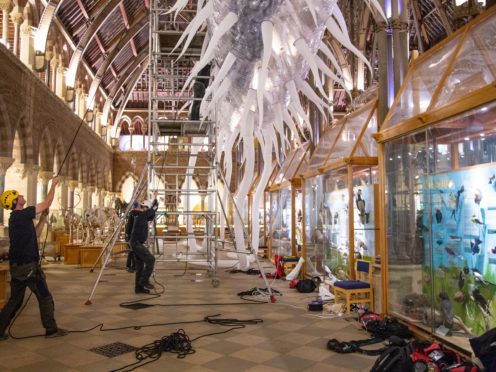A giant inflatable sculpture of E.coli has been installed in a museum as the showpiece of its new exhibition on bacteria.
Bacterial World, opening on Friday in Oxford, hopes to “rehabilitate” the reputation of bacteria.
The 92ft (28m) long sculpture took five riggers 12 hours to put in place, working through the night.

Scaffold towers were constructed to reach into the Oxford University Museum of Natural History’s vaulted roof, where the E. coli, complete with spiky pili and flagella, is tethered
The E.coli sculpture, created by artist Luke Jerram, is among 55 exhibits on the “earliest form of life on Earth” to go on show.
Deep-sea and geological specimens, as well as leafcutter ants, leeches and vampire bats, which live symbiotically with bacteria, will feature.

While mostly associated with food poisoning, illness and disease, curators describe bacteria as “remarkable organisms” which can “swim using nanoscopic motors, and battle with ‘spears’ – they sense, communicate, and remember”.
The exhibition will show how bacteria could help tackle environmental problems, including oil-spills and plastic waste.

Geological fossils will show evidence of how bacteria oxygenated the Earth 2.4 billion years ago.
Scott Billings, digital engagement officer at the museum, said: “Many unusual things happen in the museum, but installing a gigantic inflatable E. coli is definitely a first for us.
“Working all through the night, the rigging team have artfully weaved the bacterium’s tail-like flagella around the iron architecture, making Luke Jerram’s artwork a spectacular showpiece for the Bacterial World exhibition.”

Professor Paul Smith, director of the museum, said: “Bacteria are essential for almost every aspect of life on Earth, from the very origins of life itself to the deeply intricate relationships that underpin all ecosystems.
“Drawing on research from across the University of Oxford, the Bacterial World exhibition explores our very intimate relationships with bacteria and reveals the vital roles they play in enabling our planet’s huge variety of life.”
The museum’s mammal skeletons, including an elephant skeleton, were rearranged to make way for the rigging equipment for the sculpture.
Bacterial World opens on Friday and runs until May 28.
